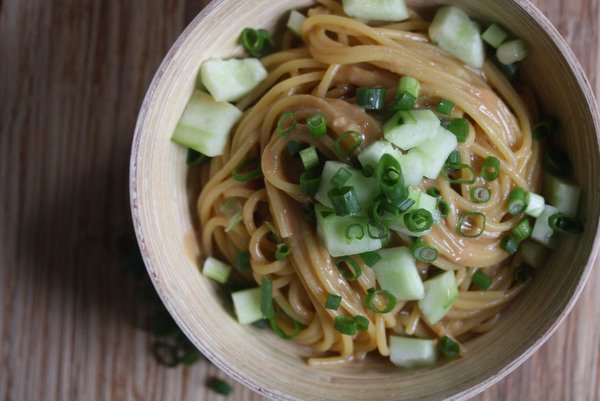As a food writer who's constantly testing recipes, I often struggle with my own wastefulness. Sure, I invite people over to partake in my creations whenever possible. But more often than not, it's just me. And then I face that same single gal dilemma that most of you do: how do you shop for one person and not end up throwing out half the food at the end of the week?
But let's first face the hurdle of cooking for one. Like going to the gym, getting yourself to use your kitchen is a habit-forming activity. It's important to carve out some time for it week-by-week, otherwise you'll be permanently conditioned to want to open your seamless web app instead of your fridge.
First, you have to make a cooking commitment to yourself. Then, back it up with cabinets full of options that, when put to use, will take less time to create a meal than delivery. Finally, you need to round them out with a few fresh ingredients that you can use up entirely, and won't rot in your fridge for the rest of the week. Here are some pointers for getting started.
--Phoebe Lapine of Feed Me Phoebe
1. Stock your pantry. The key to habitual cooking is to always have nearly an entire meal waiting to be made in your cabinets. The first stocking of your pantry will cost you some money. But hey, that's part of the commitment. Once you have the basics -- pasta, canned tomatoes, rice and grains, canned beans -- suddenly dinner's only a few fresh ingredients away. A jar of peanut butter and some condiments can become this take-out classic. A package of sun-dried tomatoes and some fresh broccoli Rabe are all you need for this pasta dish. Pick up some radishes, and you've got a killer Thai fried rice.
2. Keep pantry veggies on hand. There are certain aromatics that keep well for long periods of time in the fridge. These are great to always have on hand, and you won't have to risk throwing them away at the end of the week. My favorites are garlic, onion, carrots, celery, potatoes and lemons. Eggs, cheese and bread, are also a great basis for any meal and keep for weeks in the fridge. A refined roasted carrot soup, or the ultimate bachelor egg sandwich are at your fingertips.
3. Choose gateway products vs. effort-free fixes. Believe it or not, I am all for cutting corners if it means you'll cook more often. Any product that gets you involved -- even if it's only by way of heating up a pot of water for pasta -- is better than picking up the phone to order takeout. I'll often keep a bottle of store bought Rao's tomato sauce in the fridge and make myself a quick pasta meal. It's better to buy these corner-cutting ingredients than to stock your pantry with cup-o-noodles and canned soups.
4. Buy one or two fresh items the day of. In order to avoid throwing away half your fridge at the end of the week, it's important to use self-restraint at the market, and to do a little pre-planning before you get there. Try to limit yourself to only a few fresh ingredients to add to what you already have in your pantry, and make sure you cook it all that night. For me, these items are often one or two veggies, and then a protein -- like mushrooms and ramps for these omelets, or turkey sausage to mix with some pepperoncini and canned tomatoes in this dish.
5. Create a dedicated cooking day. Try to pick one day or night a week that's your cooking night. Then make it your goal to cook through whatever random scraps you have in your fridge that day or night. Most people like to do this on Sunday. It's a great way to have some ready-made food for the days ahead. Which brings me to the next point.
6. Brown bag it. If you ever have leftovers, make sure to get in the habit of taking them with you for lunch. The beauty of cooking is that 30 minutes at the stove can stretch to so many meals. Brown bagging it will be the key to avoiding wastefulness.
7. Use your freezer. If you know you're not going to be able to eat all of your creations, make sure you portion the extra servings out and freeze them. Things keep for a surprisingly long time in the freezer -- especially soups and stews. The quickest fixed meal around is one you only have to defrost, and better yet if it was made by you in the first place.

